Fogarty Marks 50 Years of Global Health Partnerships
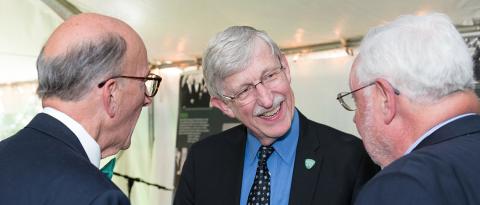
Photo: Andrew Propp
A half century of global health research and training accomplishments were celebrated May 1, as more than 500 NIH leaders, researchers, advocates and trainees gathered from around the world to mark establishment of the Fogarty International Center in 1968.
Part scientific symposium, part family reunion, the day was devoted to a review of progress in the development of research capacity in low- and middle-income countries (LMICs), its role in advancing science to reduce death and disability and an exploration of new frontiers of global health research ripe for future exploration.
“Never before in the history of global health has global collective action been more important,” said Dr. Richard Horton, editor of The Lancet, in his keynote address. With nationalism and anti-science rhetoric on the rise, evidence-based decision-making is on the decline, he continued.
“It feels like we are living through a counter-enlightenment, that some believe that the world is unsafe, unstable and insecure, that the idea of progress is actually a myth, that the promise that we have given society for what science can deliver is actually a lie.”
Horton urged the audience to stay committed to advancing science to improve health and carefully consider the evolving threats posed by climate change and environmental hazards. Fogarty should continue to provide global leadership and promote its “values of partnership, of collaboration and most importantly of all, equality among and between nations.”
FIC remains faithful to the vision of its namesake, according to Sen. Jack Reed (D-RI), who recalled that Rep. John E. Fogarty (D-RI) was known for his effectiveness, decency and kindness. Not only a champion for NIH, Fogarty also believed the U.S. had an obligation to improve health around the world. He argued for a “Health for Peace Center,” which would embody Americans’ commitment to use science for the good of mankind.
“That vision permeates this center,” said Reed.
Towards Ending HIV/AIDS
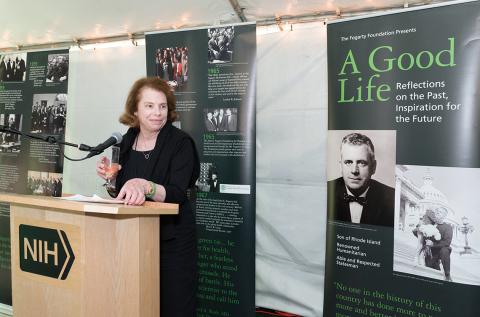
Photo: Andrew Propp
He pledged continued support for FIC and acknowledged the effective advocacy conducted on its behalf by Fogarty’s daughter, Mary Fogarty McAndrew, and her husband Tom McAndrew, who attended the celebration with their children and grandchildren.
In the first panel discussion, devoted to HIV/AIDS and infectious disease, NIAID director Dr. Anthony Fauci said the NIH investment in research that led to antiretroviral therapy (ART) literally transformed the lives of those living with HIV. ART and other advances in prevention and treatment give him optimism.
“We have no excuses,” he said. “We have the tools to end HIV/AIDS.”
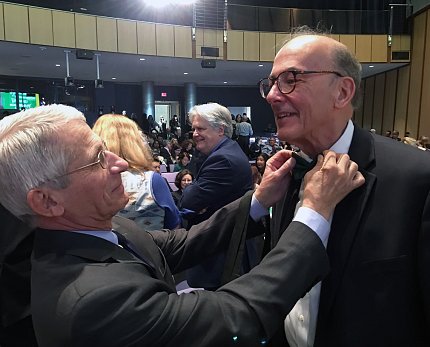
Photo: Ann Puderbaugh
Fogarty grantee Dr. Quarraisha Abdool Karim said young women in Africa pose a critical challenge to ending the epidemic there, with 5,000 new infections occurring each day. Papers published with contributions by Fogarty trainees give glimpses of the physical and behavioral reasons young women hold the key to reducing transmission, she said.
Panelists emphasized the need for implementation science to study interventions in key populations and proposed taking a community approach, addressing the underlying poverty of those at risk and examining stigma and other social factors that prevent diagnosis and treatment.
IC Directors Laud FIC Impact
The growing burden of chronic, noncommunicable diseases was also explored, with case studies presented on cancer and sickle cell disease.
NCI deputy director Dr. Douglas Lowy discussed progress in making cervical cancer screening accessible in low-resource settings using mHealth solutions. Two former Fogarty fellows who are now co-principal investigators on an NCI grant told how NIH support has changed the landscape of cancer care and research in Malawi.
NHLBI director Dr. Gary Gibbons noted that NIH programs empower country-driven contextual solutions to bend the curve and help eliminate health inequities. He detailed his institute’s global efforts to reduce household air pollution exposure, study low-cost hypertension interventions and translate advances in sickle cell disease to LMICs.
Brain disorders also cause an enormous disease burden in the developing world.
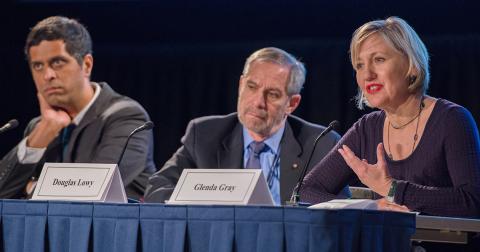
Photo: Andrew Propp
NINDS director Dr. Walter Koroshetz and his grantee Dr. Gretchen Birbeck jointly presented on stigma and epilepsy. Birbeck says her studies in Zambia have found working with peer groups and schools can be effective.
Another team, made up of NIA director Dr. Richard Hodes and grantee Dr. Kenneth Kosik, described an extended family of Colombians with a genetic mutation that brings early-onset Alzheimer’s disease. Kosik said he used Fogarty funds to build local scientific capacity to study the population and has established a brain bank there that is waiting to be explored.
NIMH has also had “fruitful partnerships” with Fogarty, said NIMH deputy director Dr. Shelli Avenevoli, and has future plans to develop LMIC data infrastructure and analytic capacity, advance implementation science and conduct research in the humanitarian context.
NIMH grantee Dr. Vishwajit Nimgaonkar presented his genomic studies of schizophrenia in India and Egypt, which he says have built capacity and formed partnerships between the countries.
Return on Investment—a Testimonial
The final session focused on the multigenerational impact of Fogarty’s research training programs.
Peruvian grantee Dr. Patty Garcia recalled how she received FIC support to earn advanced degrees in the U.S. Since returning home, she has helped build a cadre of well-trained scientists—including co-presenter Dr. Magaly Blas—that has drawn significant research funding from NIH and other sources.
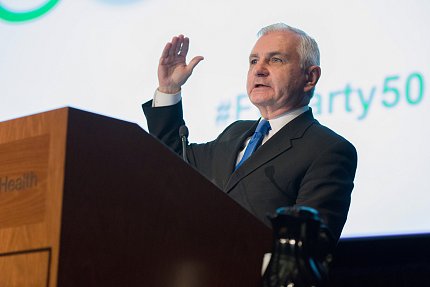
Photo: Andrew Propp
Fogarty programs in Peru helped advance understanding of infectious diseases, develop expertise in informatics, incorporate electronic medical records into the national health system and expand research into the Amazon region and other underserved areas. All the while, Garcia advanced in her career, serving as university dean, director of Peru’s NIH and recently as health minister.
“Every step you take in life shapes who you are,” she said. “And the steps I’ve walked with the help of Fogarty were instrumental in helping me to achieve a great deal, including being appointed health minister.”
FIC, ‘Great Global Village’
In South Africa, ongoing FIC support since 1992 has helped train more than 600 scientists.
“For me, the most important thing is that almost every study on HIV going on in South Africa today involves a Fogarty trainee in some way or another,” said Dr. Slim Abdool Karim. He introduced his protégé, Dr. Vivek Naranbhai, who said his experience as a Fogarty fellow was life-changing.
Naranbhai said he entered the program feeling he was an inconsequential physician, but during orientation at NIH quickly realized he had something to offer. “It introduced me to a community of like-minded people—to suddenly have access to this great global village is extraordinary.”
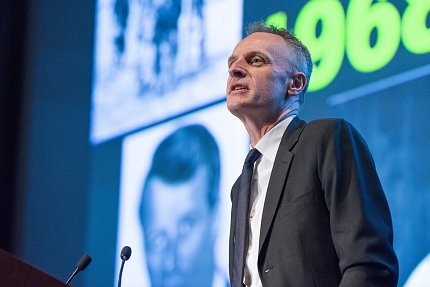
Photo: Andrew Propp
Fogarty programs that develop these local research leaders are the key to the future, said NIH director Dr. Francis Collins. “We want to increasingly empower investigators in-country to be able to be in charge of their own efforts, to figure out what the most important research questions are in their environment and then to help them build support for that within their own countries,” he said. “Even with its modest budget, Fogarty can be an incredible catalyst.”
The other ICs at NIH have been Fogarty’s greatest partners in building these international collaborations, with almost 90 percent of Fogarty grants receiving co-funding, noted FIC director Dr. Roger Glass.
“By forming and supporting these scientific partnerships, the center has tried to expand the envelope of research,” he said. “The principal value of Fogarty is investing in people and their careers.”
Watch the whole webcast at http://bit.ly/Fogarty50th.
